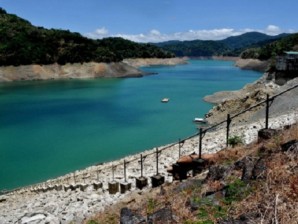MANILA, Philippines—It may be high time to put a stop to Metro Manila’s reliance on Angat Dam and consider directly getting water from the 90,000-hectare Laguna Lake, Environment Secretary Ramon Paje said on Thursday.
The official broached the viability of Laguna Lake supplying the capital’s water needs, as the level of Angat Dam, the reservoir providing 97 percent of the capital’s water, fell to 181.31 meters, just over a meter short of the critical point on Thursday.
The water in the dam is expected to hit the critical level of 180 meters in “four to five” days, decreasing by about 30 centimeters every day, according to the Philippine Atmospheric, Geophysical and Astronomical Services Administration (Pagasa).
But the water level will fall at a faster rate in the coming days.
“Angat Dam is shaped like a cone, so as the days pass, the decreases will be more dramatic,” said Pagasa hydrologist Elmer Caringal.
Paje said that once the water in Angat reached 180 meters, it would start falling “by the meter, as in one meter one day, two meters, the next day, and so on.”
Priority domestic supply
But the official allayed fears of severe water disruption in Metro Manila, as the priority of the National Water Resources Board (NWRB) was for domestic consumption in the capital.
The NWRB regularly monitors the water level in Angat Dam, which supplies 97 percent of Metro Manila’s water needs, mostly for domestic use, and
irrigation of farmlands in the nearby provinces of Bulacan and Pampanga in Luzon.
Once the water reaches the critical level, the protocol is to immediately cut the irrigation supply, and then, if the water continues to recede, the supply for electric power plants, Caringal said.
But Metro Manila has auxiliary turbines providing power; thus a major disruption to power supply is not seen.
Caringal said the lowest level Angat Dam ever reached was 157.56 meters in July 2010, during the 2009-2009 El Niño season, which led to water rationing in parts of the metropolis.
To hit in June
Pagasa earlier said El Niño, a phenomenon marked by the abnormal warming of Pacific waters, would “almost certainly” hit the country in June. In the Philippines, El Niño manifests in below normal rainfall and stronger storms.
Paje said it was too early to consider scenarios in which rationing of water would be considered necessary.
“That will only come in when the water level is at the 150 meter level, which is still a long way to go. If that happens, in places where there’s high elevation, there may be a lowering of water pressure. There will still be supply, but weaker,” he said.
Paje said farmers of Bulacan and Pampanga would bear the brunt of the water shortage. “This is unfortunate because not only would they have little water for their farmlands, they will also be affected by El Niño,” he said.
As a long-term solution, Paje said it was time to seriously study the possibility of directly taking water from Laguna Lake on a larger scale.
Originally posted at 8:14 pm | Thursday, May 8, 2014
